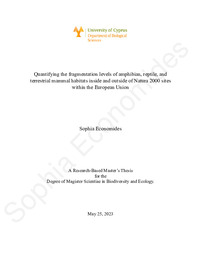| dc.contributor.advisor | Sfenthourakis, Spyros | en |
| dc.contributor.author | Economides, Sophia | en |
| dc.coverage.spatial | Cyprus | en |
| dc.creator | Economides, Sophia | en |
| dc.date.accessioned | 2023-07-05T06:08:30Z | |
| dc.date.available | 2023-07-05T06:08:30Z | |
| dc.date.issued | 2023-05-25 | |
| dc.identifier.uri | http://gnosis.library.ucy.ac.cy/handle/7/65584 | en |
| dc.description.abstract | Natural landscapes are constantly being modified and fragmented through a plethora of human activities, such as urbanisation and agriculture. Landscape fragmentation can have multiple negative effects on biodiversity. For example, it can lead various species’ populations to decrease due to the reduction of habitat area, and to become isolated into genetically vulnerable sub-populations. Certain species, such as amphibians, reptiles, and some terrestrial mammals, may be at a higher risk and experience negative impacts due to fragmentation caused, for example, by roads and barriers. This is particularly true if these species have limited mobility or require a larger living space. Species' threats can be potentially mitigated through the creation of protected areas. Species and habitats of conservation importance within the EU are being protected through the establishment of a supranational network of protected areas, the Natura 2000 sites, currently covering 26% of the EU’s terrestrial area. The EU's biodiversity strategy for
2030 includes plans to expand Natura 2000 areas, address landscape fragmentation and habitat loss, and protect a minimum of 30% of the EU's land area.
While previous studies have shown that, in some cases, significant proportions of the species distribution ranges lie within Natura 2000 sites, several knowledge gaps remain. First, the species’ calculated distribution range may include areas which are, in fact, unsuitable for them. To produce more accurate representations of a species’ suitable habitat, its area of habitat (AOH) can be derived by extracting unsuitable habitats and elevations within its geographical range. Second, although several studies have looked at what proportion of species ranges is protected (an analysis known as gap analysis), few studies have assessed and quantified the quality of the species’ protected habitat, e.g., with regards to fragmentation. It’s possible that the Natura 2000 sites themselves could have high levels of fragmentation.
In this research project we identify species groups, focusing on amphibians, reptiles, and terrestrial mammals, that may be under-protected by calculating their AOH, and quantifying it against landscape fragmented by transportation structures and anthropogenic barriers, within and outside of Natura 2000 sites. The findings can help evaluate if the protection of species is sufficient and aligns with the EU's biodiversity strategies and guidelines. They can also provide a more precise understanding of which species need priority protection. In addition, we offer biogeographic and EU country assessments of fragmentation, which provide an overview of how species in those areas are affected by fragmented landscapes, both inside and outside of Natura 2000 sites. This information can help identify conservation priorities. We also analyse species groups by IUCN threat categories to examine if more threatened species tend to have more fragmented protected and unprotected habitats.
Our results show that overall species’ habitats within Natura 2000 sites tend to be less fragmented than in unprotected areas. However, there are substantial variations across biogeographic regions and countries where protected areas can still be highly fragmented, like for example, in the Mediterranean. Furthermore, many species have most of their AOHs in unprotected areas with high fragmentation levels. | en |
| dc.language.iso | eng | en |
| dc.publisher | Πανεπιστήμιο Κύπρου, Σχολή Θετικών και Εφαρμοσμένων Επιστημών / University of Cyprus, Faculty of Pure and Applied Sciences | |
| dc.rights | info:eu-repo/semantics/openAccess | en |
| dc.rights | Open Access | en |
| dc.title | Quantifying the fragmentation levels of amphibian, reptile, and terrestrial mammal habitats inside and outside of Natura 2000 sites within the European Union | en |
| dc.type | info:eu-repo/semantics/masterThesis | en |
| dc.contributor.committeemember | Sfenthourakis, Spyros | en |
| dc.contributor.committeemember | Papadopoulou, Anna | en |
| dc.contributor.committeemember | Mammides, Christos | en |
| dc.contributor.department | Τμήμα Βιολογικών Επιστημών / Department of Biological Sciences | |
| dc.subject.uncontrolledterm | BIODIVERSITY | en |
| dc.subject.uncontrolledterm | BIODIVERSITY CONSERVATION | en |
| dc.subject.uncontrolledterm | FRAGMENTATION | en |
| dc.subject.uncontrolledterm | PROTECTED AREAS | en |
| dc.author.faculty | Σχολή Θετικών και Εφαρμοσμένων Επιστημών / Faculty of Pure and Applied Sciences | |
| dc.author.department | Τμήμα Βιολογικών Επιστημών / Department of Biological Sciences | |
| dc.type.uhtype | Master Thesis | en |
| dc.contributor.orcid | Sfenthourakis, Spyros [0000-0003-3213-2502] | |
| dc.contributor.orcid | Papadopoulou, Anna [0000-0002-4656-4894] | |
| dc.contributor.orcid | Mammides, Christos [0000-0003-1747-175X] | |
| dc.gnosis.orcid | 0000-0003-3213-2502 | |
| dc.gnosis.orcid | 0000-0002-4656-4894 | |
| dc.gnosis.orcid | 0000-0003-1747-175X | |

